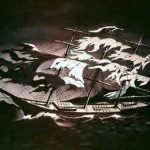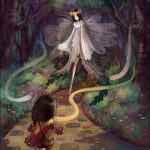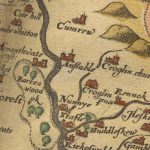It was therefore fascinating to discover within the Manuscripts Department of the University of Cambridge Library a long-forgotten file on the photograph compiled by the investigations officer for the Society for Psychical Research, Mr CVC Herbert. The file consists of over 40 notes, documents, pieces of correspondence, press cuttings and photographs compiled by Herbert and two other investigators, American psychoanalyst Dr Nandor Fodor and the famed psychical researcher Harry Price, for the International Institute for Psychical Research. [3] It is from this material that an explanation for the Brown Lady picture begins to emerge.
The key document in understanding the photograph is a typed report by Herbert, dated 14 January 1937. It appears that, alerted by the press coverage, he interviewed both Shira and Provand. He considered them truthful witnesses, although he thought Shira of a nervous and superstitious nature. He also reveals that Indra Shira was a pseudonym, but does not identify him beyond his being a Scotsman. Herbert believed Shira to be the business brain of the pair, possessing little knowledge or skill in photography.
Crucially, Herbert also examined the camera and suggested that the image might have been caused by equipment failure. He wrote:
“Film: Kodak S.S. Ortho
“Lens: “R>R> type, symmetrical doublet. Approx f/8.
“Camera: old stand camera. Provand said that the bellows were faulty, and that he was always afraid that light might get in. This is significant.
“I saw the negatives (cut films) of both exposures. The 1st (before the ‘ghost’ appeared) was much under-exposed. Exposure in each case was by daylight (high lights on stairs, etc) assisted by Sasha bulb (large size, one in each case).
“The second film (both were in one dark slide) i.e. the one with the “ghost” is obviously shaken in a vertical plane, causing doubling of all horizontal lines (or else is two exposures?) [My italics] Provand said he had noticed this, which surprised me, as it is very obvious even in the process block. Provand says camera was on a marble table or pillar and was not very rigid. He uncapped in a hurry.
“It looks as if exposure due to daylight was doubled by vibration. Flash exposure single. (See “Country Life” block).
“Both negatives show a circular marking (not clear in block) which in the second looks like a halo round the figure. This is presumably due to reflection inside the lens mount, either from high window on stairs (blocked at bottom only) or from flash.
“Shira is uncertain about where the figure was when he first saw it. It moved, he says down the stairs. Provand says he did not know that Shira had seen anything queer. He hurriedly uncapped when Shira called out, thinking that some sightseers, who were going round the house, were coming. Both Shira and Provand seemed to me to be honest. Provand says the lens was uncapped for about 6 seconds.”
Herbert also obtained a signed statement from the developer who confirmed that the image had been present on the original negative and had not been tampered with. However, close examination of the picture in conjunction with Herbert’s report shows that something has gone very wrong indeed.
Anomalies in the picture become apparent when a light and uncropped copy of the Brown Lady photograph is examined. The anomalies do not centre upon the figure – upon which the eye naturally concentrates – but what is going on in the foreground and background. On the left hand side as the viewer sees the picture, (i.e. on the Brown Lady’s right hand side) hangs a framed picture on the wall.
Immediately beneath, seemingly hovering in the air, is a duplicate image of this picture. Equally, when one looks at the length of the banisters, they do not connect, and the angles suggest that the camera has been shaken and the staircase accidentally photographed twice. Several luminous patches are also visible which suggest a doubling of the image throughout.
The copy which best demonstrates the effect is that held in the Harry Price Library in the University of London (reproduced in Anthony Hippesley Coxe’s 1973 book Haunted Britain) and copies of Shira’s original print. However, many reproductions in ghost books have used a darkened version of the print, giving the impression it was taken at night, rather than at 4 pm. Cropping of the sides of the picture has also been used to disguise the accidental doubling of images. Curiously, in no ghost book published since 1937 does an author – whether a sceptic or a believer – appear to have commented upon the defects immediately spotted by Herbert. This suggests that the assessment of anomalous images may not be a neutral act.
The Fodor and Price Investigation
A fortean maxim holds that for every expert there is an equal and opposite expert. Almost simultaneously with Herbert’s investigation, Dr Fodor visited Raynham Hall with Mr Arthur Kingston, a camera maker. Over 8–9 January 1937, they tried to reproduce the picture without success. Having identified the staircase, Fodor stated that he had no difficulty in reproducing the circumstances of the picture but with no corresponding anomalous image appearing. After photographing a living person on the stairs and comparing it with the image on the plate, he considered: “The size of the latter is about right for a shorter female figure.” Although he thought the picture genuine, he did notice a discrepancy in the accounts of the photographers, wondering whether Provand could have placed a plate in the camera if he had been under the black cloth. It appears another expert for the IIPR, a Mr Leon Isaacs, also examined the negative and considered the photograph genuine.
Fodor also interviewed Lady Townshend, who was happy to cooperate. Part of the reason for their rapport may have been that they had both contributed the previous year to a book of ghost stories, which had appeared just six weeks before the Brown Lady photograph had been taken. This was Madam ffoulkes Ghost Book, and it contained several chapters relating to the Townshend family and Raynham Hall written by the Marchioness. Obviously, this raises suspicions that the photograph was a publicity stunt for the book. However, this is contradicted by statements from the Marchioness of Townshend, who did not believe the figure to be the Brown Lady and did not want Raynham Hall “ridiculed”. Indeed, although she thought the picture spiritual in nature she did not think it was the celebrated Brown Lady. Lady Townshend recalled that Shira had arrived at the hall and hoped to photograph a ghost and wondered why the two men had not then told her they had photographed a ghost the very same day – although as the picture had not been developed at that point and Provand had seen nothing this is perhaps not so surprising. Nandor Fodor later declared his belief in the photograph, stating: “We found nothing that could normally explain Mr Indre Shira’s result”.
Similarly, Harry Price turned in a favourable report: “I will say at once I was impressed. I was told a perfectly simple story: Mr Indre Shira saw the apparition descending the stairs at the precise moment when Captain Provand’s head was under the black cloth. A shout – and the cap was off and the flashbulb fired, with the results which we now see. I could not shake their story, and I had no right to disbelieve them. Only collusion between the two men would account for the ghost if it is a fake. The negative is entirely innocent of any faking”.








